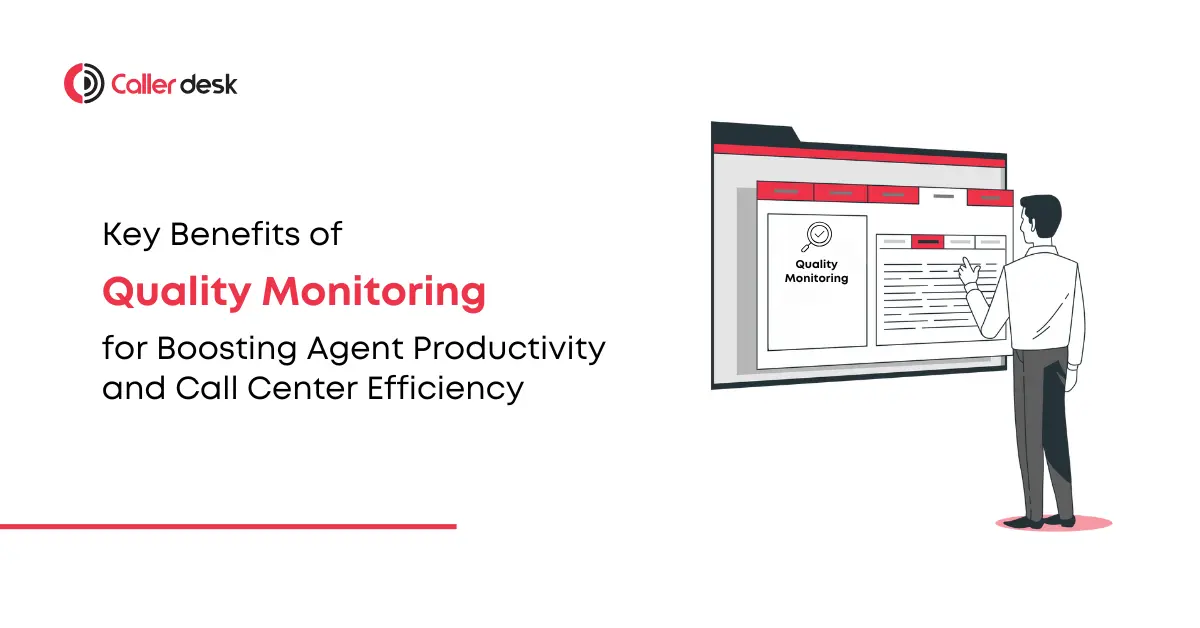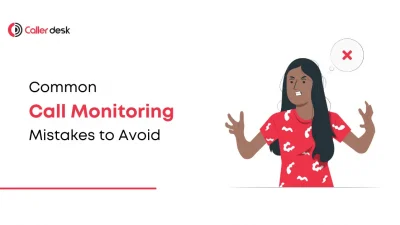Are you confident your call center is meeting its potential? In an era where customer expectations are at an all-time high, a well-functioning call center isn’t a luxury—it’s a necessity. Call monitoring is a powerful strategy to ensure your call center consistently delivers top-notch customer service while maintaining high agent productivity. It’s not just about listening to calls; it’s about refining processes, empowering agents, and optimizing outcomes to meet both customer and business goals.
In this detailed guide, we’ll explore proven best practices for call monitoring and highlight how CallerDesk’s innovative tools can transform your operations. From leveraging advanced technologies to promoting a culture of continuous improvement, these strategies will help your call center exceed customer expectations and drive business success.
1. Set Clear Objectives and KPIs
A strong call monitoring strategy begins with a clear understanding of what success looks like. Without well-defined objectives and measurable Key Performance Indicators (KPIs), it’s challenging to focus efforts effectively.
Key KPIs to Monitor:
- First Call Resolution (FCR): Tracks the percentage of issues resolved in the first interaction, directly impacting customer satisfaction.
- Customer Satisfaction (CSAT): Gathers direct feedback from customers on their experience, offering insight into service quality.
- Net Promoter Score (NPS): Measures customer loyalty by evaluating their likelihood to recommend your business.
- Average Handle Time (AHT): Monitors the time agents spend on each call, balancing efficiency with quality.
CallerDesk Insight: With CallerDesk’s performance dashboards, you can easily track and analyze these KPIs, enabling better decision-making and goal alignment.
2. Leverage Advanced Technology
Modern challenges require modern solutions. Advanced technology enables call centers to streamline operations, gain insights, and improve service quality.
Technological Tools for Effective Monitoring:
- AI-Powered Speech Analytics: Automatically transcribes calls, identifies customer emotions, and detects keywords to assess performance.
- Real-Time Monitoring: Allows managers to listen to calls live and intervene when necessary.
- Automated Call Scoring: Provides standardized evaluations of calls based on tone, clarity, empathy, and script adherence.
CallerDesk Advantage: Leverage CallerDesk’s AI-powered tools for speech analytics and real-time insights to monitor performance with precision and efficiency.
3. Prioritize Quality Over Quantity
While call volume is important, it’s the quality of each interaction that defines customer satisfaction and loyalty.
Focus Areas for Quality:
- Empathy: Ensure agents listen actively and respond empathetically to customer concerns.
- Accuracy: Provide clear and correct information in a professional tone.
- First-Call Resolution: Solve issues promptly without requiring follow-ups.
CallerDesk Solution: Use CallerDesk’s real-time call scoring to measure the quality of customer interactions and empower agents to prioritize service excellence over speed alone.
4. Provide Timely Feedback and Continuous Coaching
Call monitoring isn’t about fault-finding; it’s about creating a learning environment where agents can grow. Timely feedback and ongoing coaching sessions are vital for refining skills and boosting morale.
Steps for Effective Coaching:
- Provide Balanced Feedback: Highlight both strengths and areas for improvement.
- Encourage Self-Monitoring: Equip agents with tools like scorecards to track their progress.
- Foster Growth: Offer personalized training sessions based on specific feedback.
CallerDesk Insight: With CallerDesk’s agent scorecards, you can deliver data-driven feedback that empowers agents to take ownership of their development.
5. Incorporate Emotional Intelligence into Monitoring
Customer interactions are as much about emotion as they are about problem-solving. Agents who demonstrate emotional intelligence (EQ) can connect better with customers, resolving issues in a way that leaves them feeling valued.
How to Build Emotional Intelligence:
- Empathy Training: Teach agents to recognize and respond to emotional cues.
- Tone Sensitivity: Monitor calls for tone and adjust as needed.
- De-Escalation Techniques: Train agents to calmly manage frustrated or angry customers.
CallerDesk Insight: CallerDesk’s speech analytics detects emotional cues, allowing managers to guide agents in real time to handle situations with greater sensitivity.
6. Use Real-Time Monitoring Tools
Real-time monitoring enables managers to address issues as they happen, preventing small errors from escalating into larger problems.
Benefits of Real-Time Monitoring:
- Immediate Interventions: Managers can step in during live calls to guide agents.
- Call Analytics: Real-time data reveals trends and identifies improvement areas.
- Proactive Problem-Solving: Allows for immediate resolution of issues affecting customer satisfaction.
CallerDesk Advantage: With CallerDesk’s live monitoring tools, supervisors can listen in on calls, provide immediate assistance, and ensure service quality on the spot.
7. Empower Agents with Self-Monitoring Tools
Empowering agents to evaluate their performance creates a sense of accountability and encourages self-improvement.
Benefits of Self-Monitoring:
- Increased Accountability: Agents track their progress and take ownership of their performance.
- Improved Engagement: Self-monitoring fosters motivation and job satisfaction.
- Data-Driven Improvement: Scorecards and dashboards provide actionable insights for growth.
CallerDesk Insight: CallerDesk’s personalized performance dashboards enable agents to monitor their KPIs, giving them the tools to succeed independently.
8. Foster a Culture of Collaboration
Collaboration between managers and agents is critical for effective call monitoring. A transparent and supportive environment encourages buy-in from the team.
Collaborative Strategies:
- Team Workshops: Review top-performing calls as a team to learn best practices.
- Agent Feedback: Incorporate agent input into monitoring practices for a balanced approach.
- Recognition Programs: Highlight high-performing agents to motivate the team.
CallerDesk Integration: Use CallerDesk’s call recording and sharing features to facilitate team discussions and foster a culture of learning.
9. Choose Scalable and Customizable Systems
As your business grows, your call monitoring system must scale seamlessly to meet new challenges.
What to Look for in a Monitoring System:
- Scalability: Supports growing teams and increased call volumes.
- Customization: Adapts to unique business needs and KPIs.
- Cloud-Based Infrastructure: Ensures accessibility from anywhere.
CallerDesk Solution: With CallerDesk’s scalable cloud solutions, you can customize monitoring tools to match your evolving business needs, ensuring long-term success.
10. Commit to Continuous Improvement
The key to sustained success is a commitment to ongoing refinement. Regularly revisiting strategies ensures your call center stays agile and customer-focused.
Continuous Improvement Tips:
- Regularly review KPIs and update goals.
- Analyze trends to identify areas for growth.
- Incorporate customer feedback into your strategy.
CallerDesk Insight: Use CallerDesk’s comprehensive reporting tools to monitor trends, refine strategies, and stay ahead in a competitive landscape.
Conclusion
Call monitoring is more than just a performance assessment tool—it’s a catalyst for transformation. By implementing the best practices outlined above and leveraging CallerDesk’s advanced tools, you can enhance agent productivity, improve customer satisfaction, and optimize call center operations.
Take Action Today
Ready to take your call monitoring to the next level? Schedule a free demo with CallerDesk and experience how our innovative solutions can revolutionize your call center operations.
Frequently asked questions
1. What is call monitoring, and why is it important for call centers?
2. How can call monitoring improve agent performance?
3. What tools are commonly used for call monitoring in call centers?
Real-Time Monitoring Software: For live call evaluations.
Call Recording Systems: To review past interactions.
Speech Analytics Tools: For identifying tone, emotions, and trends.
Performance Dashboards: For tracking agent KPIs and progress.
CallerDesk provides these tools, offering an integrated suite for call quality monitoring.
4. How can real-time monitoring benefit call centers?
5. How does CallerDesk support effective call monitoring?
Real-Time Call Scoring: To evaluate live interactions.
AI-Powered Speech Analytics: To analyze customer sentiment and tone.
Customizable Dashboards: To track and optimize agent performance.
These tools help businesses streamline operations, enhance customer satisfaction, and drive long-term success.
6. What KPIs should be monitored in a call center?
First Call Resolution (FCR)
Customer Satisfaction (CSAT)
Average Handle Time (AHT)
Net Promoter Score (NPS)
Call Abandonment Rate
Monitoring these metrics ensures consistent service quality and operational efficiency.
7. How can emotional intelligence improve call center performance?
8. What are the benefits of using AI in call monitoring?
Automated call transcription.
Sentiment analysis to detect customer emotions.
Advanced insights for identifying trends and recurring issues.
AI streamlines monitoring efforts, saves time, and enhances accuracy.





